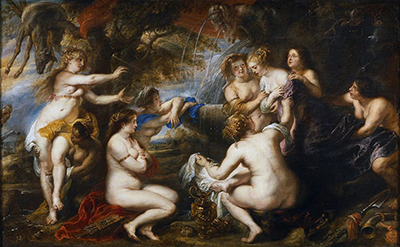Diana and Callisto is an enchanting painting by Flemish master, Peter Paul Rubens in 1637-1638 and it can now be found in the Museo del Prado alongside several other of his paintings
Rubens makes use of this theme from Roman mythology and adds his own style. The dramatic scene in this painting is at the point when an unplanned pregnancy is announced, forcing an emotional scene where friends and servants urgently re-cloth the distraught woman.
This painting was first documented in 1666 and has changed hands within Spain ever since. The Museo del Prado in Madrid, Spain offers one of the finest collections of Renaissance and Baroque art in the world and owns several key pieces from Rubens' career. Rubens' own travels across Europe are believed to have been inspired by the career of Titian, whose work he greatily admired and continually reproduced.
The influence of Titian's own depictions of Diana can be seen in this work of Rubens. Diana and Callisto and Diana and Actaeon featured similar activity across complex compositions and artist Rubens chose to study these in detail when moving across the continent. He would take in the collections of Madrid and London, amongst others as he continued around Europe in search of financial reward and new artistic inspirations.
The poses of these scantily-clad young women may remind some of the Pre-Raphaelite painting titled Hylas and the Nymphs by John William Waterhouse or even Nymphs and Satyr by William Bouguereau.
Many of Rubens compositions were oval shaped, at least in terms of the main focus. You will find this painting is typical of that, with a stretched circle of content being dipped into the light, leaving other areas in relative darkness.




